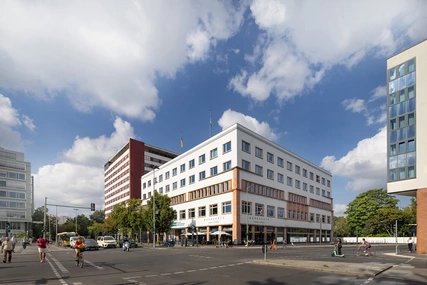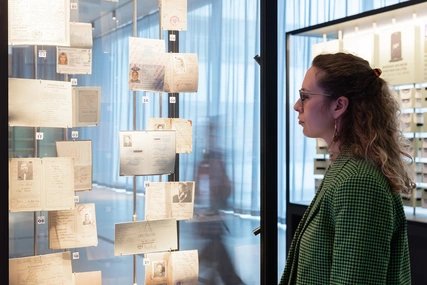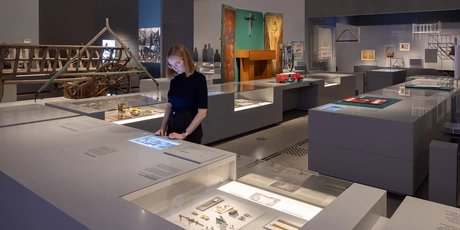
Documentation Centre for Displacement, Expulsion, Reconciliation
The stories of people forced from their homes all over Europe and beyond
The permanent exhibition of the new house on flight and expulsion opened in the listed Deutschlandhaus at Anhalter Bahnhof in summer 2021. The Documentation Centre for Displacement, Expulsion, Reconciliation is dedicated to the history of forced migrations from the 20th century to the present day and is an important place of remembrance and reminder that is well worth a visit.
Every displaced person's fate is an individual tragedy of loss, flight and the struggle to arrive. The new Documentation Centre Displacement, Expulsion, Reconciliation at Anhalter Bahnhof thus addresses a topic that is as painful as it is universal and timeless. The exhibition explores the causes and effects of forced migration in 20th century Europe.
Confront the past to improve the present
Located a short walk from the Topographie des Terrors (Topography of Terror), this Documentation Centre, alongside the likes of the Erinnerungsstätte Notaufnahmelager Marienfelde (Marienfelde Refugee Centre Memorial Site) , is part of a growing landscape of institutions dedicated to confronting the past in Europe and Germany while documenting and highlighting the more difficult elements of their history. These centres all share a determination that the past should never be repeated and that the best way to ensure this is looking directly at the history we instinctively want to shy away from. Forced migration remains enormously prevalent in our world today. People are still forced to leave their homes due to conflict. Warlike and armed conflicts, ethnic tensions as well as interstate conflicts continue to lead to millions of people being forced to leave their homes against their will and try to build a new life for themselves.

Permanent and temporary exhibitions
The reasons for forced migrations in the twentieth century were usually political, ethnic or religious or, indeed, a combination of all three. This permanent exhibition aims to explore these themes as can be seen on the first two floors of the building. The ground floor houses temporary exhibitions. The permanent exhibition contains original objects, documents and photographs telling the stories of displaced groups: from Belgians evacuated to the Netherlands as World War I broke out to Germans forced westwards as the Red Army advanced through Poland and Czechoslovakia in the later stages of WWII to forced migrations in Rwanda and Bosnia in the 1990s and modern day Syria.

The artefacts include:
- An ID card for French citizens in Alsace after WW1. The province was ceded to France by Germany, and Germans were forced to leave the area.
- Part of a mortar shell detonated in Sarajevo in February 1994, killing 60 civilians.
- A life vest retrieved from Pozallo, Italy in 2016. Over 1,300 refugees have died attempting to cross the Mediterranean Sea to get to Europe.
- A small kitchen set of pots and cutlery given to refugees by the UNHCR upon their arrival at a refugee camp in Bangladesh.
- A bag fashioned from old potato sacks by a family fleeing East Prussia in 1945.
Atmosphere of remembrance with maximum accessibility
The documentation centre is naturally an informative, sombre and tranquil place. The atmosphere of remembrance is complemented by the architecture: the original façade is maintained while the interior has been entirely rebuilt to create a wide open foyer section with two impressive staircases. The two sections of the building are linked by a narrow gap allowing daylight to beam through. Steps have also been taken to make the building as accessible as possible to as many people as possible. This includes a tactile guidance system, stations that can be experienced by touch and videos in German sign language. The audio guides are also available in plain language.
How to get there
The documentation centre is directly opposite S-Bahnhof Anhalter Bahnhof, served by trains S1, S2, S25 and S26 and buses M41 and M49. It’s a fifteen-minute walk from U-Bahn stations Potsdamer Platz (U2), Mendelssohn Bartholdy Park (U2), Möckernbrücke (U1, U3, U7).
Other nearby attractions
A well-preserved strip of the Berlin Wall runs along Niederkirchnerstraße, just a 5-10 minute walk away. Right next to it is one of Berlin’s most-visited museums, the Topography of Terror, located on the site of the former headquarters of the Gestapo, the Nazi secret police, documenting the evil acts committed during the Third Reich. From there, Checkpoint Charlie is a five-minute walk away.
Tue - Sun 10 am - 7 pm
Library and Contemporary Witness Archive:
Tue - Fri 10 am - 7 pm
